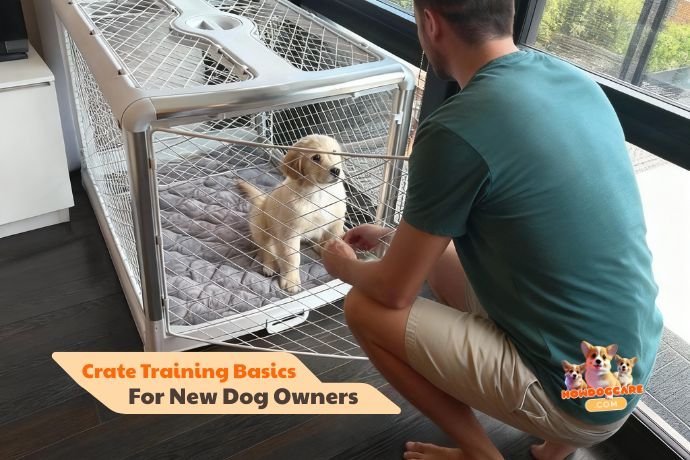Welcoming a new puppy into your home is one of life’s greatest joys—but it also comes with its fair share of challenges. One of the smartest decisions you can make as a new dog owner? Getting a handle on crate training basics. When done correctly, crate training creates a structured environment that nurtures your pup’s development and supports your sanity. From choosing the right crate to developing a realistic training routine, this guide will walk you through everything you need to know about puppy essentials with a focus on crate training for beginners.
Introduction to Crate Training for Puppies
What is Crate Training?
Crate training is the practice of using a designated, secure crate (or kennel) as your puppy’s personal space. Think of it like a bedroom—one that teaches your dog to relax, sleep, and feel safe. It’s not just about containment. It’s about comfort, structure, and discipline. This is especially important in the early stages of puppyhood when your furry friend is learning boundaries and routines.
The key is to associate the crate with positive experiences. This isn’t a timeout zone or a punishment room—it’s a chill spot for naps, snacks, and alone time. Your dog will instinctively learn that the crate is their “den,” which appeals to their natural instincts. You’ll find it helps with housebreaking, reduces destructive chewing, and even makes travel easier.
Why Crate Training is Crucial for New Dog Owners
Crate training is more than a popular trend—it’s one of the most effective training tools in modern dog parenting. Here’s why it matters:
- Housebreaking support: Dogs rarely soil their sleeping area, which makes crate training ideal for potty training.
- Establishes routines: You can create feeding and sleep patterns easily within the crate.
- Protects your puppy: When you’re not around, the crate keeps them from getting into things they shouldn’t.
- Encourages independence: Crate time helps pups learn to self-soothe and settle without constant attention.
- Prepares for vet visits and travel: A crate-trained dog is calmer during transport and boarding.
Without crate training, new dog owners often deal with chewed-up shoes, random accidents, and general chaos. That little metal or plastic box might just be your new best friend.
Common Misconceptions About Crate Training
Despite its benefits, crate training often gets a bad rap. Here are some myths to stop believing:
- “It’s cruel.” Not if done right. Dogs crave routine and security. A crate provides both.
- “My puppy will feel trapped.” Actually, they’ll feel safe. A properly trained puppy loves their crate.
- “I should never close the door.” While you want them to enter willingly, closing the door gradually teaches boundaries and independence.
The truth? Crate training doesn’t mean locking your pup away all day. It’s about creating a reliable space for rest and learning.
How to Choose the Right Crate for Your Puppy
Top-rated Crates by Size and Breed
Not all crates are created equal. The best crate for a Chihuahua isn’t the same as the best crate for a German Shepherd. The goal is to find one that’s just big enough for your pup to stand up, turn around, and lie down comfortably.
Here are some top-rated options by size:
- Small Breeds (Yorkies, Pomeranians): MidWest Homes for Pets iCrate – compact, foldable, and affordable.
- Medium Breeds (Cocker Spaniels, Bulldogs): FDW Dog Crate with Double Door – sturdy with a divider for growing puppies.
- Large Breeds (Labradors, Golden Retrievers): Petmate Ultra Vari Kennel – airline-approved and durable.
Look for models that come with a divider panel. This way, you can adjust the size as your puppy grows—a huge win for new dog owners trying to budget wisely.
Materials: Wire, Plastic, or Soft-Sided?
There are three main crate types, and each has pros and cons:
- Wire Crates: Great airflow, collapsible, often come with dividers. Perfect for home use.
- Plastic Crates: Ideal for travel and dogs who like a darker, cozier space.
- Soft-Sided Crates: Lightweight and portable but not chew-proof—best for calm, crate-trained dogs.
Choose based on your dog’s behavior and your lifestyle. A wire crate works for most indoor uses, but plastic is better for mobility.
Crate Features That Make a Difference
When selecting a crate, look for features that make your life easier:
- Removable tray for quick cleaning
- Dual doors for flexible room placement
- Divider panel to grow with your pup
- Secure latches to prevent escapes
- Carrying handles or wheels for portability
Little upgrades can make a big impact—especially when cleaning up puppy messes at 2 a.m.
Best Crates for Crate Training Based on Dog Size
Best Small Dog Crate for Apartment Living
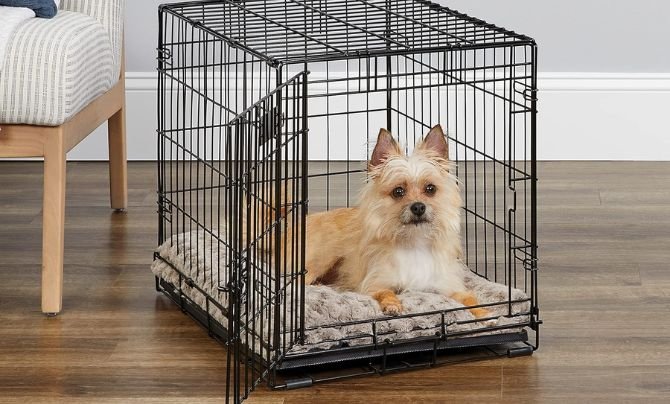
If you’re living in a compact space with a small breed, the MidWest iCrate Single Door Fold & Carry Dog Crate stands out.
Pros
- Lightweight and easy to carry
- Foldable for storage
- Divider included
- Affordable price point
Cons
- No wheels for mobility
- May rattle if not secured tightly
It’s compact, easy to move, and doesn’t take up much space—great for tiny pups in city apartments.
Best Large Dog Crate for Active Breeds
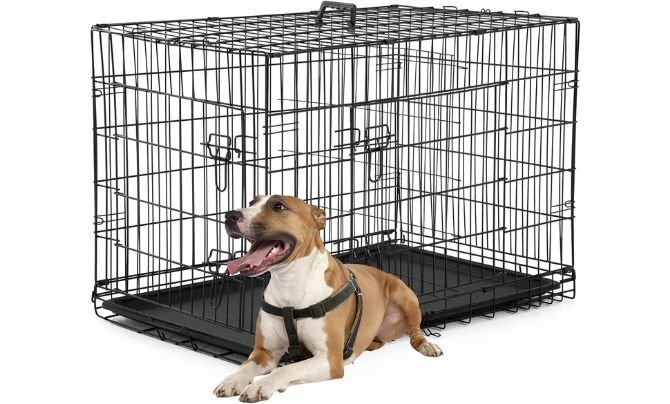
For energetic breeds like Labs or Boxers, durability is non-negotiable. The FDW Dog Crate Dog Kennel Cage with Double Door is a solid pick.
Pros
- Heavy-duty steel frame
- Dual locks for safety
- Spacious and well-ventilated
- Great for large, strong breeds
Cons
- Heavier than other crates
- Assembly required
A bit bulky, but perfect if you have a powerful pup who likes to push boundaries.
Budget-Friendly vs Premium Options Compared
If you’re torn between affordability and premium features, here’s a quick breakdown:
- Budget Choice: AmazonBasics Foldable Metal Crate – simple, reliable, cost-effective.
- Premium Pick: Diggs Revol Dog Crate – sleek, safe, with a collapsible design and wheels.
Both work well depending on your budget, but the premium model adds luxury touches worth considering if you plan to use the crate long-term.
Step-by-Step Crate Training Basics
How to Introduce the Crate to Your Puppy
Introducing your puppy to their crate the right way can make or break the training process. First things first: the crate needs to feel like a fun, inviting space—not a punishment zone. Start by placing the crate in a quiet, low-traffic area where your puppy feels comfortable. Make it cozy with soft bedding and toss in a few of their favorite chew toys.
Begin crate introduction sessions slowly:
- Leave the door open and let them explore the crate on their own.
- Place high-value treats near and inside the crate to build curiosity.
- Feed their meals just outside the crate at first, then slowly move the bowl inside.
- Use a calming, enthusiastic tone when saying crate-specific commands like “Go to bed” or “Crate time!”
Once they’re comfortable going in and out freely, begin closing the door for short periods while staying nearby. Gradually increase this time until your puppy can remain calm in the crate alone. Patience is key here. The goal is to create positive associations—not rush the process.
Feeding and Sleeping Schedules Inside the Crate
Once your puppy is familiar with their crate, you can incorporate structured feeding and nap times into crate use. Dogs thrive on routine, and having consistent schedules helps regulate digestion, energy levels, and behavior.
Here’s how to make it work:
- Feed inside the crate with the door open at first, then begin closing the door during meals.
- After feeding, take them outside to potty immediately. This reduces accidents and builds good habits.
- Schedule regular nap times inside the crate during the day—right after playtime is best.
- Bedtime should always be in the crate, ideally in a dark, quiet area to promote calm sleep.
Over time, your dog will associate the crate with rest and security. If they resist initially, don’t give in to whining or barking. Stick to your routine and reward calm behavior with praise or treats.
Avoiding Crate Training Mistakes
Even well-meaning pet parents can trip up crate training if they’re not careful. Here are some common pitfalls to avoid:
- Using the crate for punishment: Your puppy should never associate the crate with fear or isolation.
- Leaving your dog crated too long: Puppies have small bladders! Young pups shouldn’t be crated for more than 2–3 hours during the day.
- Skipping the introduction phase: Throwing your pup in the crate and shutting the door will backfire fast.
- Inconsistency: If crate use is unpredictable, it confuses your dog. Stick to schedules.
- Lack of comfort: Don’t make your crate a cold metal box. Add a bed, blanket, and safe toys.
Crate training takes time, but it works. Be consistent, patient, and positive. Your dog will thank you.
Must-Have Puppy Essentials for Successful Crate Training
Best Puppy Bedding for Crates
Comfort is crucial for successful crate training. The right bedding not only helps your pup sleep better but also prevents sore joints and anxiety. Look for machine-washable, chew-resistant, and orthopedic options designed for puppies.
Top Pick: MidWest QuietTime Deluxe Crate Mat
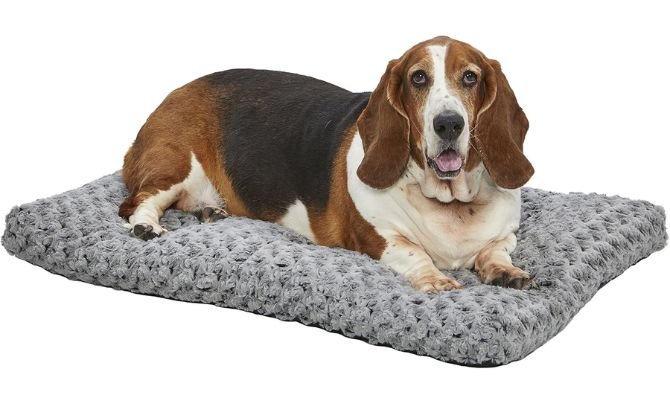
Pros
- Plush, padded surface
- Fits standard crates perfectly
- Affordable and widely available
- Machine washable
Cons
- Not ideal for aggressive chewers
- Requires frequent washing with messy pups
If your pup is a chewer, consider crate-safe beds like K9 Ballistics Tough Orthopedic Bed. It’s pricier but designed for durability.
Top-rated Chew Toys and Crate Distractions
Chew toys can make a world of difference during crate time. They serve as distractions, soothe anxiety, and satisfy your puppy’s natural urge to gnaw.
Must-have crate-friendly toys:
- KONG Puppy Toy: Fill it with peanut butter or kibble to keep your pup busy for hours.
- Nylabone Puppy Chew Toys: Great for teething relief and oral health.
- Zogoflex West Paw Toppl: Interactive and dishwasher-safe.
Avoid soft plush toys with small parts or squeakers—they’re choking hazards in confined spaces.
Safe Water Dispensers for Crated Puppies
Keeping your pup hydrated while crated is essential—especially if they’re in there for more than an hour. The ideal crate water solution is spill-proof and easy to clean.
Best Choice: Choco Nose No-Drip Dog Water Bottle
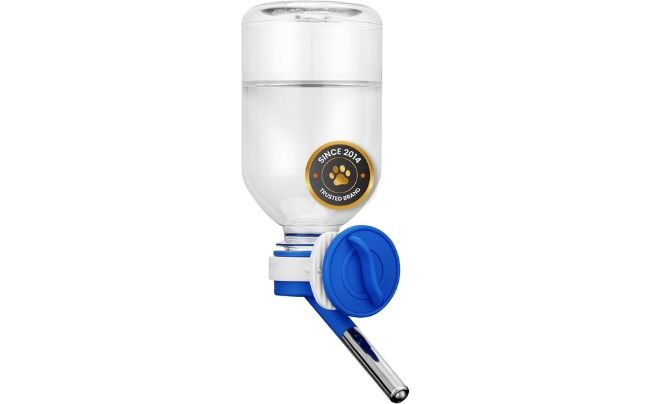
Pros
- No-spill design
- Easy to mount on wire crates
- BPA-free and safe for puppies
- Affordable and available online
Cons
- Smaller capacity—needs refilling
- Not suitable for larger breeds
For medium and large breeds, consider stainless-steel bowl clips or crate bowl sets that attach securely to the crate bars.
Creating a Puppy Crate Training Schedule
Sample Daily Routine for an 8-Week Old Puppy
Establishing a daily routine is one of the best tools in your crate training toolkit. Puppies are creatures of habit, and a consistent schedule makes them feel secure.
Here’s a typical crate-focused routine for an 8-week-old pup:
| Time | Activity |
|---|---|
| 7:00 AM | Wake up, potty break |
| 7:15 AM | Breakfast (in crate) |
| 7:45 AM | Potty break, playtime |
| 9:00 AM | Crate nap |
| 11:00 AM | Potty, snack, brief training |
| 12:00 PM | Crate lunch + quiet time |
| 1:00 PM | Potty, play, short walk |
| 2:00 PM | Crate nap |
| 4:00 PM | Potty break, more play |
| 6:00 PM | Dinner (in crate) |
| 6:30 PM | Potty, cuddle time |
| 8:00 PM | Crate downtime, last potty |
| 9:30 PM | Crate for the night |
Adjust based on your schedule, but keep feeding, potty, and sleep times consistent.
Adjusting the Schedule as Your Puppy Grows
As your puppy matures, they’ll need fewer crate naps and more active time. Around 4–6 months, you can extend their crate stays and reduce midday naps. At 6+ months, many dogs can sleep through the night and handle longer stretches without potty breaks.
Just remember:
- Increase crate time gradually
- Always reward calm behavior
- Watch for signs of stress or anxiety and adapt accordingly
How Long Can You Leave a Puppy in a Crate?
A general rule of thumb is your puppy’s age in months = maximum crate hours (up to 6 hours).
| Puppy Age | Max Crate Time (Day) |
|---|---|
| 8 Weeks | 2 hours |
| 12 Weeks | 3 hours |
| 16 Weeks | 4 hours |
| 6+ Months | 5–6 hours (daytime) |
| Overnight | 6–8 hours (with potty break early on) |
Never use the crate as a substitute for interaction, exercise, or mental stimulation. It’s a tool—not a lifestyle.
The Best Accessories to Upgrade Your Crate Setup
Crate Covers: Comfort and Calming
Sometimes, even the most well-designed crate can use a little help creating a cozy, den-like feel. That’s where crate covers come in. They block out excess light, reduce stimulation, and offer a comforting cave-like atmosphere—especially helpful for anxious puppies or nighttime crate training.
Top Pick: MidWest Crate Cover
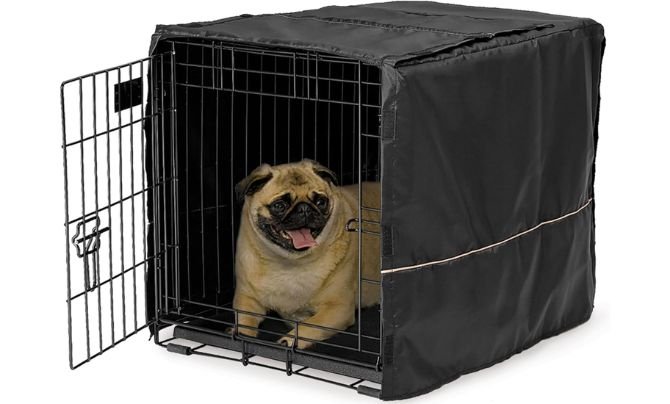
Pros
- Lightweight cotton/poly fabric
- Machine washable
- Velcro flaps for ventilation control
- Stylish design options
Cons
- May not fit all crate models perfectly
- Not chew-resistant
A crate cover can reduce nighttime whining and help your pup feel protected, much like blackout curtains for a baby nursery. For a budget option, a heavy towel or blanket can also do the trick—just be cautious with puppies who like to chew.
Odor-Free Pads and Liners for Easy Cleaning
Let’s face it—accidents happen. Especially in the early stages of crate training. That’s why waterproof crate liners and absorbent pads are non-negotiables. They make cleanup easier, protect your flooring, and help maintain a hygienic crate environment.
Best Choice: Paw Inspired Washable Crate Liners
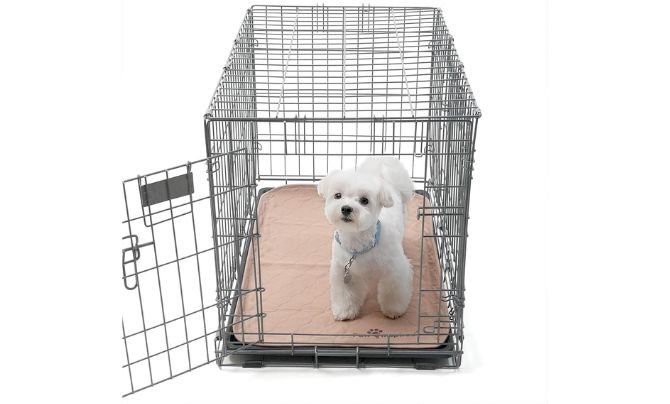
Pros
- Leakproof design protects crates and floors
- Washable and reusable, reducing waste and costs
- Non-slip bottom keeps pad securely in place
- Durable material suitable for daily use and whelping
- Eco-friendly alternative to disposable pee pads
Cons
- May require frequent washing for heavy users
- Not completely chew-proof for destructive puppies
- Takes time to air dry compared to disposables
For younger puppies, layer an absorbent puppy pad underneath the liner to catch unexpected messes. Just be sure your pup isn’t tempted to chew on the pad itself.
Digital Monitors and Puppy Cameras
If you’re a new dog parent with a full-time job, chances are you’re wondering what your puppy’s up to while you’re gone. Enter: smart pet monitors. These gadgets let you check in, talk to your pup, and even dispense treats remotely. It’s a modern way to monitor crate behavior and catch early signs of anxiety or boredom.
Top Pick: Furbo 360° Dog Camera
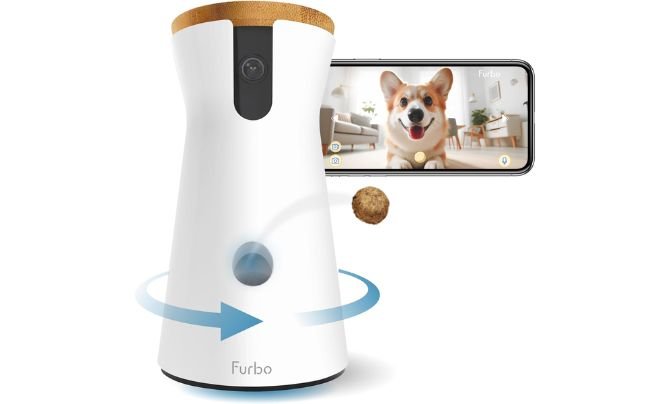
Pros
- Treat-tossing feature
- Washable and reusable, reducing waste and costs
- Two-way audio communication
- 360° wide-angle camera
Cons
- Premium features require a subscription
- Higher price point
Whether you’re dealing with separation anxiety or just want peace of mind, this accessory is worth every penny for serious crate trainers.
Related Articles
Troubleshooting Common Crate Training Issues
Puppy Crying or Barking in the Crate
One of the biggest concerns new puppy owners face during crate training is whining, barking, or howling when the crate door closes. It’s heartbreaking, we get it—but it’s not forever. Understanding why it’s happening is the first step to fixing it.
Common causes include:
- Lack of exercise before crate time
- Need to potty
- Fear of isolation
- Hunger or thirst
Here’s how to address it:
- Ignore minor whining at bedtime. If you respond every time, you’ll reinforce the behavior.
- Use background noise like a fan or white noise machine to soothe them.
- Ensure they’re tired. A good play session before bedtime helps burn off energy.
- Stick to a routine. Puppies thrive on predictability.
If the barking persists for more than a week, reassess the crate placement and pre-crate routine. A camera can also help you understand their behavior when you’re out.
Accidents Inside the Crate: What to Do
Puppies will have accidents—it’s part of the learning curve. But frequent messes inside the crate can slow down progress and cause frustration. Usually, the problem boils down to one of three things:
- Crate is too large (they’re using one side to potty)
- Puppy is crated too long
- Feeding too close to bedtime
Fix it fast:
- Use a divider to reduce excess space.
- Track meals and ensure potty breaks follow 15–30 minutes after.
- Clean thoroughly with an enzymatic cleaner—dogs will revisit spots that still smell.
Accidents aren’t setbacks—they’re signals. Learn from them and adjust accordingly.
When to Know It’s Time to Upgrade the Crate
As your puppy grows, their crate needs may change. A too-small crate becomes uncomfortable, while a too-large one might encourage bad habits.
Signs it’s time to size up:
- They can’t turn around or stretch fully
- They’re resistant to entering the crate
- They’ve outgrown their divider
If your current crate doesn’t meet your dog’s evolving needs, it might be time to upgrade to a permanent adult crate. Look for models with built-in mats, better ventilation, and travel-friendly options.
Vet and Trainer Tips for Effective Crate Training
What Professionals Say About Crate Duration
Veterinarians and certified dog trainers agree—crate training works, but only when used properly. According to professionals:
- Puppies under 6 months shouldn’t be crated for more than 3–4 hours at a time during the day.
- Overnight crate time should be broken with potty breaks, especially in the early weeks.
- Use positive reinforcement only—never force your pup inside or use yelling.
Their biggest tip? Use crate time as a learning opportunity, not a punishment. If your dog is whining, look for causes instead of reacting emotionally.
Behavior Clues That Indicate Progress
How do you know if your crate training is actually working? Look for these signs:
- Puppy enters the crate willingly without prompting
- Calms down quickly after being placed inside
- Sleeps soundly and doesn’t bark excessively
- No longer has accidents inside the crate
Celebrate these wins—they mean your pup is adapting beautifully. Take photos, brag to your friends, and treat yourself to a victory coffee.
Training Treats That Motivate Puppies
Want your dog to love their crate? Start with the right bribes—I mean, training tools. Treats are the best motivators for any puppy learning a new behavior.
Best crate-training treats:
- Zuke’s Mini Naturals – low-calorie, soft, and flavorful
- Wellness Soft Puppy Bites – packed with nutrients
- KONG Easy Treat Spray – great for lining inside KONG toys
Keep the treats consistent and exclusive to crate time. This creates a “crate = rewards” mindset that speeds up training dramatically.
The Long-Term Benefits of Proper Crate Training
Easier Travel and Vet Visits
One of the most underrated benefits of crate training is stress-free transportation. Whether it’s a trip to the vet or a vacation across the country, a crate-trained dog travels better, stays calmer, and transitions more smoothly.
- No more car anxiety
- Fewer accidents during long rides
- Easy boarding or pet sitting arrangements
Crate-trained dogs are also more welcome in hotels, friends’ homes, and professional settings because they come with their own portable space.
Creating a Safe Space for Life
Dogs are den animals by nature. Even as they grow older, many return to their crates voluntarily for quiet time or naps. It becomes their personal sanctuary—a place to unwind away from chaos, loud kids, or strangers.
This safe space is invaluable during:
- Thunderstorms
- Fireworks
- House parties
- New pet introductions
Give your dog their “room,” and they’ll repay you with better behavior and fewer stress-induced issues.
Reducing Destructive Behavior While You’re Away
Chewed-up shoes. Torn furniture. Mysterious puddles. These are common complaints from dog owners who skip crate training. A crate minimizes damage by restricting unsupervised access to your home during the early, destructive months.
When paired with proper exercise and mental stimulation, a crate-trained dog is:
- Less anxious
- Less bored
- Less destructive
Crate time isn’t about confinement—it’s about peace of mind for both you and your pup.
Conclusion: Crate Training Basics—Your Path to a Well-Behaved Puppy
Crate training isn’t just about keeping your pup in one place—it’s about creating structure, comfort, and peace of mind. For new dog owners, it can feel overwhelming at first. But with patience, the right tools, and a positive attitude, crate training transforms into one of the most rewarding aspects of pet parenting.
From choosing the top-rated crate for your dog’s size, to sticking to a realistic schedule and learning how to troubleshoot common issues, the process becomes much smoother once you understand the fundamentals. Add in some essential accessories like cozy bedding, spill-proof water bowl, and smart pet monitors, and you’re setting your pup (and yourself) up for long-term success.
Let your crate become a haven, not a prison. Let your training become bonding time, not a battle. And most importantly—let your puppy learn, grow, and thrive with confidence.
When done right, crate training fosters independence, prevents accidents, and strengthens the bond between you and your new best friend. You’ve got this—and so does your puppy.
FAQs
At what age should I start crate training my puppy?
You can begin crate training as early as 8 weeks old. That’s typically when most puppies are brought home. The earlier you start, the easier it is to establish good habits and routines. Just be sure to keep sessions short and positive to avoid overwhelming your puppy.
What if my puppy hates the crate?
Many puppies resist at first—but that doesn’t mean they hate it. It’s usually a response to newness, not discomfort. Ease them in with treats, praise, toys, and short sessions. If they whine or bark, remain calm and consistent. Most puppies come to love their crate with time and patience.
Can I leave my puppy in the crate while I’m at work?
Not for extended periods. Young puppies need frequent potty breaks and interaction. If you work full time, consider hiring a dog walker, using a playpen, or setting up a pet camera for mid-day check-ins. Long isolation can hinder socialization and progress.
Should I crate my puppy at night?
Yes—nighttime crate training helps with housebreaking and creates a bedtime routine. Just remember to take your pup out for potty breaks during the night if they’re under 4 months old. Use calming bedding, reduce stimulation, and keep the crate near your bed at first.
How do I know crate training is working?
You’ll see your pup voluntarily entering the crate, settling down quickly, and sleeping through the night without accidents. They’ll start using it as a place to relax, not just when prompted. That’s when you know you’re winning at crate training.


